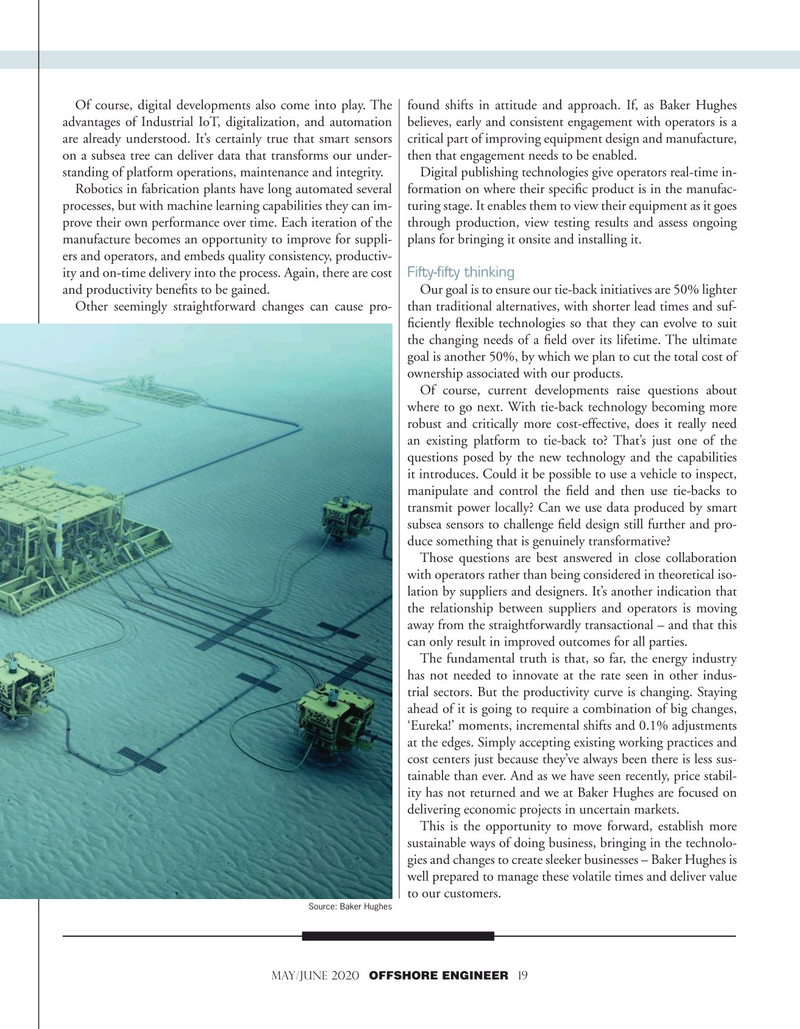
Page 19: of Offshore Engineer Magazine (May/Jun 2020)
Read this page in Pdf, Flash or Html5 edition of May/Jun 2020 Offshore Engineer Magazine
Of course, digital developments also come into play. The found shifts in attitude and approach. If, as Baker Hughes advantages of Industrial IoT, digitalization, and automation believes, early and consistent engagement with operators is a are already understood. It’s certainly true that smart sensors critical part of improving equipment design and manufacture, on a subsea tree can deliver data that transforms our under- then that engagement needs to be enabled. standing of platform operations, maintenance and integrity. Digital publishing technologies give operators real-time in-
Robotics in fabrication plants have long automated several formation on where their specifc product is in the manufac- processes, but with machine learning capabilities they can im- turing stage. It enables them to view their equipment as it goes prove their own performance over time. Each iteration of the through production, view testing results and assess ongoing manufacture becomes an opportunity to improve for suppli- plans for bringing it onsite and installing it. ers and operators, and embeds quality consistency, productiv- ity and on-time delivery into the process. Again, there are cost Fifty-fifty thinking and productivity benefts to be gained. Our goal is to ensure our tie-back initiatives are 50% lighter
Other seemingly straightforward changes can cause pro- than traditional alternatives, with shorter lead times and suf- fciently fexible technologies so that they can evolve to suit the changing needs of a feld over its lifetime. The ultimate goal is another 50%, by which we plan to cut the total cost of ownership associated with our products.
Of course, current developments raise questions about where to go next. With tie-back technology becoming more robust and critically more cost-effective, does it really need an existing platform to tie-back to? That’s just one of the questions posed by the new technology and the capabilities it introduces. Could it be possible to use a vehicle to inspect, manipulate and control the feld and then use tie-backs to transmit power locally? Can we use data produced by smart subsea sensors to challenge feld design still further and pro- duce something that is genuinely transformative?
Those questions are best answered in close collaboration with operators rather than being considered in theoretical iso- lation by suppliers and designers. It’s another indication that the relationship between suppliers and operators is moving away from the straightforwardly transactional – and that this can only result in improved outcomes for all parties.
The fundamental truth is that, so far, the energy industry has not needed to innovate at the rate seen in other indus- trial sectors. But the productivity curve is changing. Staying ahead of it is going to require a combination of big changes, ‘Eureka!’ moments, incremental shifts and 0.1% adjustments at the edges. Simply accepting existing working practices and cost centers just because they’ve always been there is less sus- tainable than ever. And as we have seen recently, price stabil- ity has not returned and we at Baker Hughes are focused on delivering economic projects in uncertain markets.
This is the opportunity to move forward, establish more sustainable ways of doing business, bringing in the technolo- gies and changes to create sleeker businesses – Baker Hughes is well prepared to manage these volatile times and deliver value to our customers.
Source: Baker Hughes
MAY/JUNE 2020 OFFSHORE ENGINEER 19

 18
18

 20
20